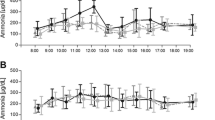Abstract
Oral glutamine challenge is a method to increase blood ammonia and may be used to study the ammonia lowering effect of drugs potentially useful in hepatic encephalopathy (HE). We tested its influence on the psychometric performance of 18 cirrhotic patients without HE. Twelve nonencephalopatic cirrhotic patients were studied before and after glutamine load (20 g in 100 mL tap water) and six patients before and after placebo (100 mL tap water) by using the Number Connection Test (NCT), the Covert Visual Attention Orienting Test (CVAOT), and the Scan Test (SCT). Blood ammonia increased significantly after glutamine (from 79 ± 34 to 211 ± 66 μg/dL) but not after placebo (from 94 ± 41 to 88 ± 26). No difference in the NCT was found before and after glutamine load or placebo. The CVAOT was similar after glutamine challenge and placebo, nor any interaction between Loads (glutamine or placebo) × Cue position was found, suggesting that glutamine load did not influence attention-orienting. SCT results were also similar after glutamine and placebo, suggesting a lack of influence on the working memory. Glutamine challenge is a safe method to induce hyperammonemia in nonencephalopatic cirrhotic patients and, therefore, to study the efficacy of ammonia lowering treatments.
Similar content being viewed by others
Author information
Authors and Affiliations
Rights and permissions
About this article
Cite this article
Masini, A., Efrati, C., Merli, M. et al. Effect of Blood Ammonia Elevation Following Oral Glutamine Load on the Psychometric Performance of Cirrhotic Patients. Metab Brain Dis 18, 27–35 (2003). https://doi.org/10.1023/A:1021926601907
Issue Date:
DOI: https://doi.org/10.1023/A:1021926601907




